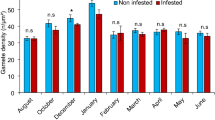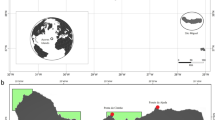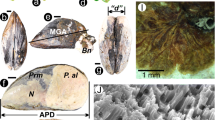Abstract
Animals that bore into calcareous material can cause considerable damage to molluscan shells. In contrast, smaller microbial phototrophic endoliths have until recently been thought of as relatively benign. Phototrophic endoliths (primarily cyanobacteria) infest the shells of 50 to 80% of midshore populations of the mussel Perna perna (L.) in South Africa. This infestation causes clearly visible shell degradation, and we record here ecologically important lethal and sub-lethal effects (e.g. changes in growth and reproductive output) of the endoliths on their mussel hosts. Endolith infestation reduced the strength of shells significantly and also affected shell growth. In situ marking of shells, using the fluorochrome calcein, showed that infested and non-infested mussels increased in shell length at the same rate. However, the rate of increase in shell thickness (associated with shell repair) was significantly faster in infested than in uninfested individuals. This increase in the rate of shell thickening was not sufficient to compensate for rapid endolith-induced shell degradation and, around the site of adductor muscle attachment, infested shells were thinner than their uninfested counterparts. The shells of 18% of recently dead mussels had holes induced by endolith erosion. This effect was highly size dependent, and the proportion of mortality due to endoliths rose to almost 50% for the largest mussels. The re-routing of energy due to shell repair had important sub-lethal effects on the reproductive rates of mussels. During the reproductive period, mean dried flesh mass for large (>70 mm), non-infested P. perna was substantially higher than for infested individuals. This difference was almost entirely due to differences in gonad mass, which was approximately 100% higher for non-infested mussels. We conclude that, by attacking the shell, phototrophic endoliths reduce both the longevity and reproductive output of large mussels on the midshore.
Similar content being viewed by others
Author information
Authors and Affiliations
Additional information
Received: 26 January 1999 / Accepted: 17 August 1999
Rights and permissions
About this article
Cite this article
Kaehler, S., McQuaid, C. Lethal and sub-lethal effects of phototrophic endoliths attacking the shell of the intertidal mussel Perna perna . Marine Biology 135, 497–503 (1999). https://doi.org/10.1007/s002270050650
Issue Date:
DOI: https://doi.org/10.1007/s002270050650




